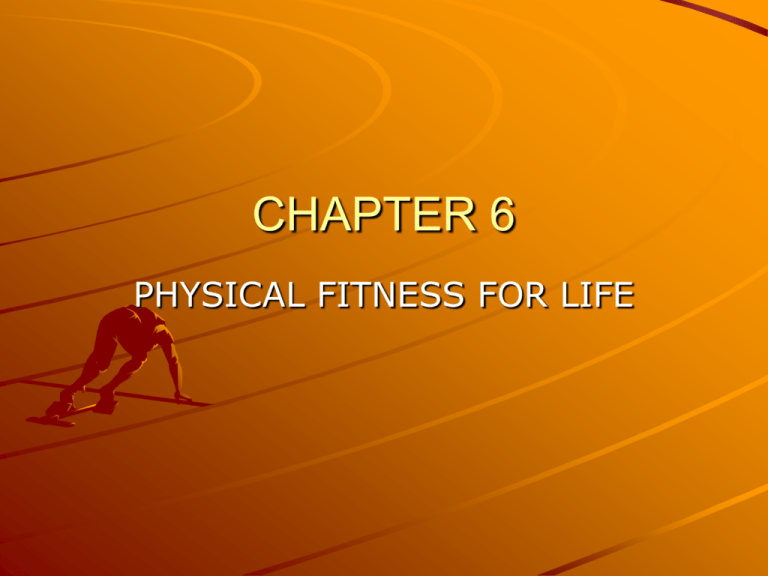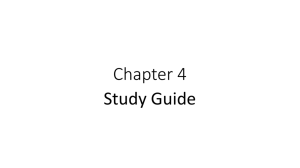CHAPTER 6
advertisement

CHAPTER 6 PHYSICAL FITNESS FOR LIFE Bellringer Make a list of ALL the benefits of being physically fit that you can think of. I will be checking in your notebook for these…each 1 will be worth ONE point! What’s Your Health IQ? 1. To gain the benefits of exercise, you must exercise everyday. 2. Exercise can help improve depression. 3. Girls will develop large, manly muscles if they lift weights. 4. Lifting weights develops cardiorespiratory endurance. 5. Anabolic steroids are illegal drugs. Section 1: Physical Fitness and Your Health PHYSICAL FITNESS The ability of the body to perform daily physical activities without getting out of breath, sore, or overly tired CHRONIC DISEASE A disease that develops gradually and continues over a long period of time Stroke Cardiovascular Disease High Blood Pressure Diabetes Physical benefits of physical activity Heart and lungs get stronger Builds muscular strength, endurance, and flexibility Good muscle to fat ratio Metabolic rate is increased Mental benefits of physical activity Reduce anxiety Reduce depression Increase selfconfidence Improve image Increased energy Social benefits of physical activity Working together on a team Develop communication skills Meet new people HEALTH-RELATED FITNESS 5 qualities that are necessary to maintain and promote a healthy body 5 COMPONENTS OF HEALTHRELATED FITNESS MUSCULAR STRENGTH MUSCULAR ENDURANCE CARDIORESPIRATORY ENDURANCE FLEXIBILITY BODY COMPOSITION 1. MUSCULAR STRENGTH Amount of force that a muscle can apply in a given contraction example: lifting weights 2. MUSCULAR ENDURANCE The ability of the muscles to keep working over a period of time example: cross country skiing Anaerobic Activity Muscle cells produce energy without using oxygen Intense and short in duration Weight training Baseball Other examples? 3. CARDIORESPIRATORY ENDURANCE The ability of your heart, lungs, blood vessels, and blood to deliver oxygen and nutrients to all of your body’s cells example: running As this increases your heart beats slower and stronger 4. FLEXIBILITY The ability of the joints to move through their full range of motion example: stretching 5. BODY COMPOSITION Refers to the ratio of lean body tissue to body fat tissue Body fat increases and muscle mass decreases Muscle does not turn into fat when you stop exercising example: eating healthy BODY FAT PERCENTAGE Females: 14-21% Males: 9-15% RESTING HEART RATE (RHR) The number of times the heart beats per minute while at rest RECOVERY TIME The amount of time it takes for the heart to return to RHR after an activity Section 2: Planning Your Fitness Program Bellringer Make a chart that describes: – What fitness activities you presently engage in – How often you do these activities – How long you participate in the activity each time you do it – How intensely you exercise What to think about before starting??? Do you have any health concerns Are you healthy enough What types of activities do you enjoy How much will your planned activities cost TARGET HEART RATE ZONE A heart rate range within which the most gains in cardiorespiratory health will occur Normally between 60-85% of your maximum heart rate Calculate Your THR Zone 1. Determine your MHR 220-age 2. Find your THR zone *multiply your MHR by .6 and also by .85 THR for a 16 year old 220 – 16= 204 204 * .6 = 122 204 * .85= 173 122 – 173 beats per minute Sit-Up Standards BOYS Age 14 24-25 Age 15-17 24-47 GIRLS Age 14 18-32 Age 15-17 18-35 One Mile Run Standards BOYS Age 14 9:30-7:00 Age 15 9:00-7:00 Age 16-17 8:307:00 GIRLS Age 14 11:008:30 Age 15 10:308:00 Age 16-17 10:008:00 FITT A formula made up of frequency, intensity, time, and type of exercise Cardiorespiratory Endurance Frequency: 3 to 5 times per week Intensity: 85% MHR for 20 minutes 60% for 60 minutes TIME 20 to 60 minutes Type: aerobic activity such as jogging Muscular Strength / Endurance Frequency: 2 to 4 days per week Intensity: 8 to 12 reps 2 to 3 sets Time: 30 to 60 minutes Type: anaerobic activity such as weight lifting When will I see results??? The length it takes to see a difference varies from person to person. On average, it takes about 6 weeks to really notice a difference. DON”T GET DISCOURAGED!!!!! Section 3: Exercising The Safe Way DEHYDRATION A state in which the body has lost more water than has been taken in OVERTRAINING Caused by exceeding the recommendations of the FITT formula Ways to Avoid Sports Injuries Get conditioned Warm up and Cool down Avoid dehydration Avoid overtraining Warning Signs of Overtraining Permanent Injury Feelings of chronic fatigue Dehydration Loss of appetite and weight Loss of interest in working out Poor athletic performance and poor school performance “Records are meant to be broken, not Athletes” Cal Ripken JR. Treating Minor Sports Injuries Protect Rest I ce C ompression E levation COMMON INJURIES and TREATMENT Connective Tissue Ligament: connects bone to bone Tendon: connects muscle to bone Cartilage: found in various parts of the body especially joint. Cushions against shock Ligament Sprain Cause: forcing a joint to move beyond its normal limits can cause ligament fibers to tear Treatment: RICE and strengthening of the muscles and tendons around the joint through rehabilitation FRACTURE Cause: extreme stress and strain causes cracks in bone Treatment: immediate medical attention; rest and immobility for 6 to 8 weeks CONCUSSION Cause: a blow to the head, face, or jaw that causes the brain to be shaken in the skull Treatment: rest under observation; medical attention if there is unconsciousness COMMON SUPPLEMENT INGREDIENTS AND DRUGS CAFFEINE How does it affect the body? A central nervous system stimulant that makes you feel awake and alert Dangers: raises blood pressure and heart rate; affects sleep, mood, and behavior; can lead to dehydration by increasing urination ANABOLIC STEROIDS How does it affect the body?: increase muscle size and strength Dangers: increase aggressive behavior, and risk of kidney tumors; can cause severe acne, testicular shrinkage, and fatal damage to heart muscle; can stunt growth in teens Section 4: Sleep TEENS NEED ABOUT 9 HOURS AND 15 MINUTES OF SLEEP A NIGHT STAGES OF SLEEP NREM: non rapid eye movement REM: rapid eye movement or “dream sleep” TIPS FOR GETTING ENOUGH SLEEP Develop a routine Exercise daily Limit caffeine Relax Say “NO” to all nighters Your bed is for sleep “I should have stopped playing video games earlier last night” KEY TERMS Insomnia: an inability to sleep, even if one is physically exhausted Sleep apnea: a sleeping disorder characterized by interruptions of normal breathing patterns during sleep Narcolepsy: Falling asleep at random times





